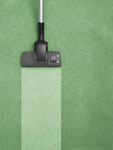Articles
Are Backpack Vacuums Back in the Limelight?
Categories: Cleaning Applications
By Doug Berjer | February 20, 2018 << Back to Articles
Accessible by: anyone
Commercial backpack vacuum cleaners were first made available in 1987. Since then, they have certainly had their supporters and enthusiasts. However, backpack vacuums still have a much smaller market share of the overall professional vacuum cleaner market than upright models. This is most true in the United States, where uprights are by far the most frequently selected vacuuming system in residential and commercial settings.
However, there are some indicators that interest in backpacks is increasing, such as:
- The technology has been refined and significantly improved over the years
- Today’s systems are much more ergonomic and comfortable to wear and use compared to earlier models
- The enhanced worker productivity that results from using a backpack is now undisputed.
Regarding the first two points, cleaning professionals in the market for a new vacuum are first encouraged to test drive a backpack. Invariably, buyers―especially new customers or ones who have not shopped for a new machine recently―will be surprised at many of the new and sometimes standard features available on some backpack models. Most manufacturers are now offering third- or fourth-generation backpacks, building on the proven advancements made over the decades.
As to the last point, ISSA published the first worker productivity studies in 1999 (now known as the 612 Cleaning Times) comparing a backpack vacuum cleaner to an upright machine. Those studies compared a 14-inch, two-motor upright vacuum cleaner with a 14-inch (floor tool) backpack vacuum. These were the results:
- The upright machine was able to clean 3,240 square feet per hour
- The backpack was able to clean 7,407 square feet per hour.
Other studies have been conducted since these initial reports and while the actual square footage may vary, in all studies, the backpack machine comes out ahead. This is important to know for cleaning contractors and other cleaning professionals. Many contractors are charging about the same per square foot as they were a decade ago and yet, virtually all of their costs have increased. The only way they can compete—or survive—is to find new ways to speed up worker productivity.
Are They More Thorough?
While few people question that backpacks can speed up vacuuming, many cleaning contractors wonder if this advancement comes at the expense of effectiveness. This issue was evaluated several years ago in an older study that is still considered credible and of value today. In fact, because so many backpack systems have been improved since the study was conducted in 1997, it is possible the results today might even be better.*
The researchers at QUEST (Quality Environmental Services & Technologies) sprinkled 100 grams of soil onto a 36-square-foot commercial-grade carpet. The soil was worked into the carpet using a carpet rake. The areas were then vacuumed using a two-motor upright and a backpack. After vacuuming, QUEST researchers calculated the percentage of soil removed from the carpets by weighing the filter bags. The results were:
- The upright removed between 87.9 and 94.9 percent
- The backpack removed between 91.3 and 96.1 percent.
While not a dramatic difference, the test proved that contrary to prevailing opinion at the time—and possibly still today for some people—the backpack provided more thorough cleaning. A more effective vacuum cleaner not only helps protect the health of a facility, but it can also help improve worker productivity. This level of thoroughness means cleaning professionals do not have to re-vacuum areas in order to get them thoroughly clean.
How to Select a Backpack Vacuum Cleaner
If you’re considering a backpack machine, the following guidelines about what to look for might come in handy:
- Cost. Backpack vacuums will range in price from under US$300 to as much as $1,000. Just as when purchasing other equipment, buyers should not base their decision solely on price or think that a less expensive machine cannot perform as sufficiently as a more expensive machine. Instead, closely examine each machine’s features and benefits in various cost categories. Make note of some of the key features you are most interested in, such as comfort, effectiveness, and air filtration characteristics—all of which we will discuss next—and then see which machine meets your requirements and is most cost effective.
- Comfort. Wear the machine and even use it at a job location if that is possible. A more comfortable backpack is typically one that is relatively light, weighing about 10 pounds. It should also feature a padded harness, contoured shoulder straps and waist belts to better distribute the machine’s weight and make it more comfortable to wear, and noise suppression for quiet operation.
- Air filtration. Backpack vacuum cleaners have led the way when it comes to improved air filtration systems. Many had HEPA filtration systems as standard equipment long before many uprights. With multiple air filtration systems, along with HEPA filters over the exhaust, a backpack should be able to capture and hold up to 99.97 percent of allergens and impurities, preventing them from becoming airborne.
- Ease of use. Comfort and ease of use go hand-in-hand. If a machine is bulky, too large, or poorly designed, it can be uncomfortable to use, especially for a user of small stature and regardless of the ergonomic or comfort features incorporated in the backpack. Two options are to continue looking for the right machine or consider selecting a smaller backpack, such as a six-quart machine.
Cleaning professionals have many options when it comes to selecting a vacuum cleaning system. And many backpack manufacturers also offer other types of vacuum cleaners, including canisters and uprights. However, those in the market for a new machine owe it to themselves to take a fresh look at modern backpack systems. Very likely, they will be in for a surprise.

About the Author.
Doug Berjer is product manager for CFR Corp., a manufacturer of recycling carpet extractors. For more information about CFR, visit www.cfrcorp.com.


